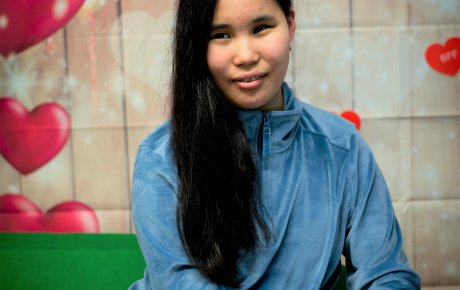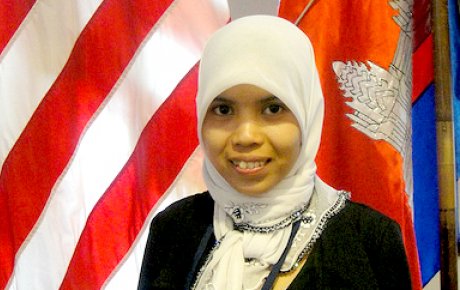430x242_fulbright-story.jpg
 Fulbright Foreign Student alumna Uyanga Erdenebold with her seeing-eye dog, Gladys.
Fulbright Foreign Student alumna Uyanga Erdenebold with her seeing-eye dog, Gladys.
“Not all blind people in Mongolia are as fortunate [as I was].” Uyanga said. “Because of the challenges, many have given up studying, even though they have equal intellectual ability.”
Most of the challenges Uyanga faced in her education related to reading and finding information. Confronted daily with the lack of availability of reading material for blind people, Uyanga developed a special interest in the ability of libraries to serve their local communities.
“I was always dependent on others to help me,” Uyanga said. “I felt I had little control over my time. I typically had to rely on the assistance of others to read materials to me, which I then typed into Braille. For all my life as a student, I dreamed of one day sitting in a library reading room and finding the materials I needed on my own.”
This motivation led her to apply for the Fulbright Foreign Student Program.
In 2007, Uyanga was awarded a Fulbright grant to study at Louisiana State University’s School of Library and Information Science in Baton Rouge, where she had access to many new resources.
“I received audio books from the U.S. Library of Congress’ National Library Services for the Blind and Physically Handicapped. This service [brought] the world of literature to me. I [enjoyed] it so much that sometimes I [stayed] up late at night to catch up with my school work,” Uyanga said.
For Uyanga, however, the most important step she would take toward independence would not be found in a book but instead through a Labrador dog named Gladys.
Gladys is the guide dog that Uyanga received during her time in Louisiana. The two trained together with an instructor and soon formed an unbreakable bond of trust. From there, Uyanga began to experience independence as never before.
“Gladys not only guides me through physical obstacles, but she also guides me through the emotional barriers and difficulties of life. I cannot imagine how it would be without her. She is as much a part of me as my legs or my hands,” Uyanga said.
It is no surprise, then, that after receiving her Masters in Library and Information Science, Uyanga took Gladys back home to Mongolia with her. There, Gladys has become a superstar in her own right as the first trained seeing-eye dog in Mongolia. Life for Gladys is very different in Mongolia, where there are no guide dogs or instructors. Of particular difficulty, there are no laws regulating the rights of guide dogs and users to have access to public places, such as shops, schools, hospitals, restaurants, or public transportation.
“At first, nobody had any idea what kind of a dog she was. They all thought I was a weird person who put a ‘handle’ on my dog for attention. [Women and children] would scream and jump away when they saw Gladys walking near them or approaching them. They would leave the elevator if we got on with them,” Uyanga said.
It was through Uyanga and her success, however, that Gladys began to win over public opinion. Following her grant, Uyanga obtained a position working for the U.S. Embassy in Ulaanbaatar - the sort of prestigious position that, according to Uyanga, is typically very difficult for a blind person to attain in Mongolia. As a result, she started receiving unsolicited requests for TV and newspaper interviews. It was through these public appearances that Mongolians began to fall in love with Gladys.
“After a few newspaper interviews and TV appearances, people started to recognize Gladys on the street and started to be much more friendly. Some restaurants and coffee shops allowed us in and most children came to know Gladys by name,” Uyanga explained. “Now, when we walk on the street, people tend to know that I’m a blind person and that Gladys is a guide dog helping me. When we run into children at our apartment complex, mothers don’t pull their children away, but tell them not to be afraid of Gladys, and that she is a good and working dog.”
“Things are slowly changing, and I came to realize that I myself need to reach out and educate the public about service animals. I am starting to see that once they see what she means to me, Mongolians can be as understanding as anybody else. Although there are many places we are still not allowed in and many people who still think Gladys should be left outside doors. We have a long ways to go, but I think we have made the start. Now it is a matter of reinforcing it.”
Uyanga will continue to move forward to educate the Mongolian public about the usefulness and companionship of service animals. She cannot forget how much her experience in the United States has changed her.
“I found the real me, not defined by my disability, in the United States. When you give someone the opportunity to not be restricted by their disabilities or differences, the actual individual emerges from behind the disability. I didn’t feel ‘disabled’ in America, sometimes I even forgot about it. I stopped building my life and my dreams to accommodate my disability, something I have always done in the past. Rather, I started building my life and dreams around me as an individual and let my disability accommodate them.”
Watch Uyanga’s TedX presentation on understanding and acceptance in a challenging world from December 2013.



